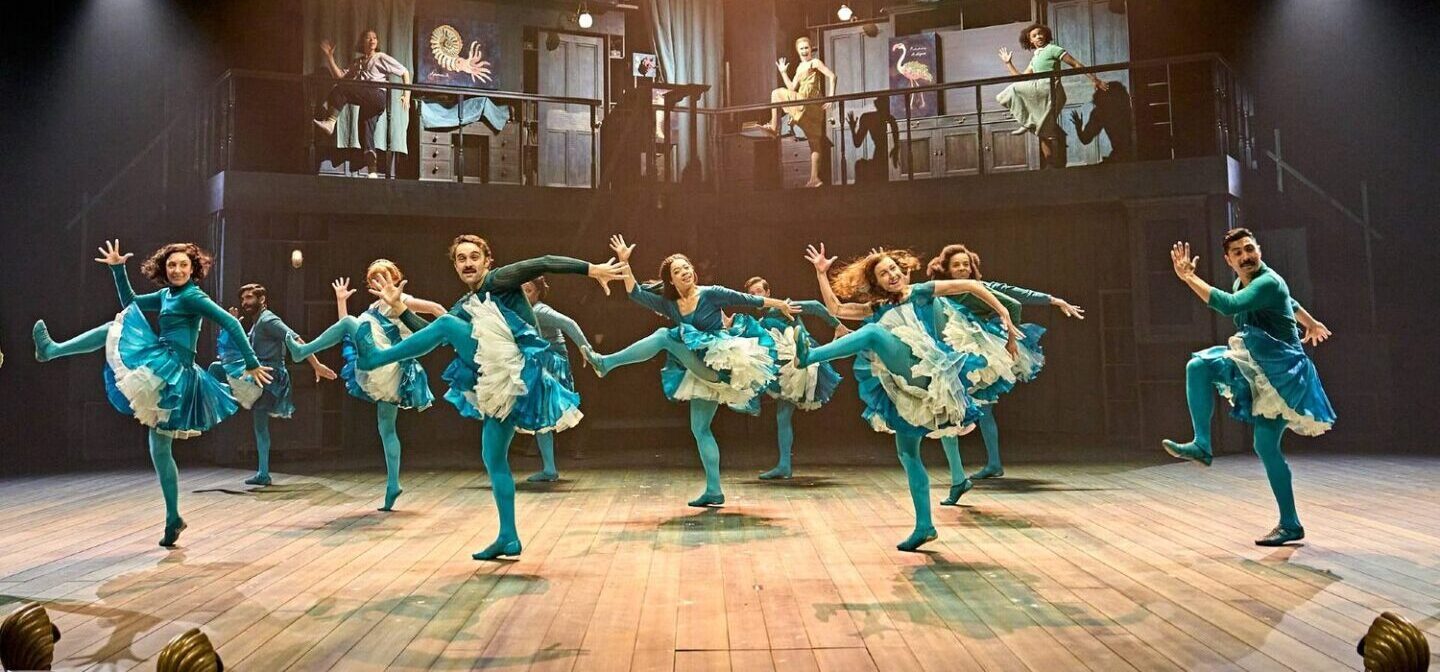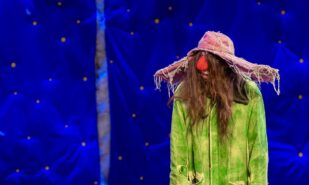Noel Streatfeild’s novel was written in the 1930s and became wildly successful—there wasn’t a child in the United Kingdom who hadn’t read the story about the lives of three adopted little girls. They all bear the telling surname Fossil but dream of different things: Pauline dreams of dramatic theater, Petrova (that’s her first name, not her surname!)—of becoming a car mechanic, and Posy, clutching the blue silk pointe shoes with shiny buckles inherited from her mother, dreams of ballet.
To You, Little One! A Romantic Story About Growing Up at the National Theatre
Ballet Shoes at the National Theatre is, without a doubt, a theatrical attraction. Everything spins, makes noise, dances, moves; sails are filled with wind, and the motor of a car roars. There are so many visual discoveries that the audience could classify them as a traveler would catalog shells and relics.
The novel has been adapted for the screen twice (in the 2007 film, Emma Watson played Pauline), but there has never been a stage production—let alone one of this scale. Naturally, Kendall Fever, the author of the stage adaptation, reworked the novel considerably, but the main storyline remains intact.
The story is overflowing with characters to the brim; it feels like they could spill out into the audience or onto the streets. But no—the performance begins in the theater itself: before the action starts, the audience is lifted from their seats and guided through a ballet warm-up. Ballet teachers in green tutus raise their arms in different parts of the auditorium, and the audience obediently follows each movement.
Sometimes Ballet Shoes feels too constrained on stage, prompting actors to leap into the auditorium or even fly through the air on long harnesses over the heads of the audience (eliciting delighted gasps). The massive Olivier Theatre stage is used to its fullest potential, with the action unfolding on multiple levels at once. Performers run and dance on the stage floor, sit and dangle their legs from shelves, slam doors, laugh, and shout across the house’s second-floor gallery. Even the highest shelves, filled with ancient artifacts, light up and go dark, as if winking.
The three girls—Pauline (Courtney George), Petrova (Yanexi Enriquez), and Posy (Daisy Sequerra)—are cast into the home of a professor by tragicomic circumstances (imagine, each journey brings another foundling!). They grow up under the care of the housekeeper Sylvia and a nanny, quarrel and reconcile, until adolescence, the threat of losing their beloved home, and the need to work suddenly descend upon them.
Oh, Sylvia (Pearl Mackie)—faithfully awaiting the traveler. One can’t help but think of Maria Vasilievna Tatarinova, the loyal wife of the captain who left on an expedition, tragic and reserved. But this is a diametrically opposite character: energetic and full of a zest for life, Sylvia always chooses life.
Each scene rarely lasts more than five minutes, and portraying a character in such a rapid rhythm is incredibly challenging. Yet, thanks to the production’s “digest-like” quality, every teenager in the audience can imagine themselves in each role. It’s an incredibly uplifting performance. Each of you, the play seems to say, is a fossil—a rare and remarkable wonder. You each have your path, and whatever it may be, the most important thing is to follow your heart.
The girls grow up, help their family, and pursue their aspirations. There is no place for self-sacrifice or losing oneself here—only a journey forward, even through exhaustion, mistakes, and fear—always forward. Straight from the motto: “To strive, to seek.” Perhaps it’s this subtle allusion—certainly unintended, as Two Captains and Ballet Shoes were written at the same time—that creates a phenomenal sense of catharsis throughout both acts.
The play lasts over two hours—but no, it doesn’t last; it rushes. Scenes follow one another at breakneck speed, yet not for a moment do the artists or directors lose their sense of proportion. There isn’t a single misplaced tone, extra color, unnecessary leap, or gimmick pandering to the audience. A dizzyingly complex technical production, the play balances poetic drama with situational comedy, dance, and pantomime.
Take the play-within-a-play scene: in the novel, poor Pauline becomes an understudy in Alice in Wonderland, portrayed here not as pantomime but through set design. At these moments, the audience might wonder about the production’s budget: the ingeniously crafted rabbit hole, the living cards, or the houses where Alice grows and shrinks appear on stage only once.
The central dramatic (or perhaps tragic?) storyline doesn’t even belong to the girls but to the old ballerina Madame Fidolia, the teacher at Posy’s ballet school. Played by Justine Salinder, the performance avoids buffoonery, caricature, or even a hint of humor. It’s an absolutely precise and meticulously crafted composite, drawing on dozens of real-life older ballerinas. Every carefully observed detail is fused into one character.
When Madame Fidolia is on stage, the performance’s vibrant carousel suddenly slows, its horses pause in first position, and at the center of the stage stands the tall, slender ballerina with regal posture. Her silhouette is exquisitely enhanced by her costume: a velvet cloak trimmed with fur and sparkling with rhinestones, shimmering in shades of red and terracotta. A turban adorned with red sits high on her head, glinting with the fine rims of her glasses.
Her recognizable accent, hard vowels, and rolling “r”s reflect utmost precision, concealing an extraordinary vitality that bursts through the broken bricks of a life shattered by revolution and emigration. Emigration—represented by two suitcases—suddenly reveals a plate, a towel, and a couple of books, remnants of a cherished former life. Madame’s death, performed on stage, is utterly heartbreaking.
But then the scene shifts, Madame vanishes, and the carousel resumes its whirling pace. At the center of this entire story is, of course, Uncle Gum’s house.
And here’s something incredible: the same actor, Justine Salinder, plays Uncle Gum, the girls’ adoptive father. This dual performance is a masterpiece—two completely opposing roles, effortlessly leaping from one to the other, imbuing both with the profound tragedy of loneliness. It becomes clear—the endless journey, the homelessness, and the relentless fate driving both characters without pause.
In the play’s finale, the girls leave the house. They couldn’t save its walls, but they’ve grown into themselves. Each has their path, their journey, and their losses. And losses are nothing to fear. What matters is to carry your ballet shoes with you—your dream, your heart.





